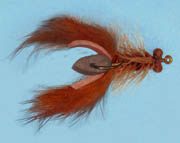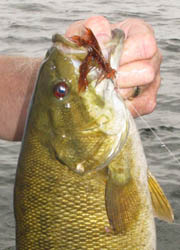
HiTail Craw
This pattern isn’t for every situation. This unique fly is designed specifically for tempting wary or inactive smallmouth with a very slow-paced bottom presentation.
Used properly, this fly can do what no other patterns do. With weight in the front and its upriding tail, the HiTail Craw can be crawled or slowly hopped along the bottom, while its pincers always remain visible and upright, and wave enticingly. In fact, because the highly flexible rabbit hair pincers quiver and pulse even when the fly isn’t moving, this fly appears alive even when at rest!

This wary smallmouth could not resist the HiTail’s waving tail
It’s Alive, Pluck it Up
Because it looks alive when at rest, fish will often first examine the HiTail and then pluck it off the bottom when it isn’t moving. (We’ve actually watched them do this underwater.) This is something smallies seldom do with other patterns.
This means that retrieves can be extremely slow and you can keep the fly in a small zone for long periods, allowing the fish extra time to bite. Sometimes slowly dragging the fly a foot or two and then allowing it to remain stationary for 5 to 8 seconds is the best way to tempt the most inactive fish.
Using the HiTail
Here are some things to know about using the HiTail–
- Because it is worked right along the bottom it works best in areas with mostly gravel substrates. If the bottoms has lots of broken rock, the fly will snag a lot.
- HiTail strike detection requires extra attention. If fish take the fly when its stationary, the line won’t be tight, so a good strike indicator is essential. Peg your indicator just 18 inches higher than the water depth (so 5 1/2 feet above the fly for a 4-foot-deep spot).
- Strikes are often very light and fish quickly spit the fly out, so your hook setting must be even quicker.
- Prime locations for the “crawling” the HiTail Craw are slack water pools and eddies. The lack of current means your leader will remain tighter and strike detection is easier.


No comments yet.